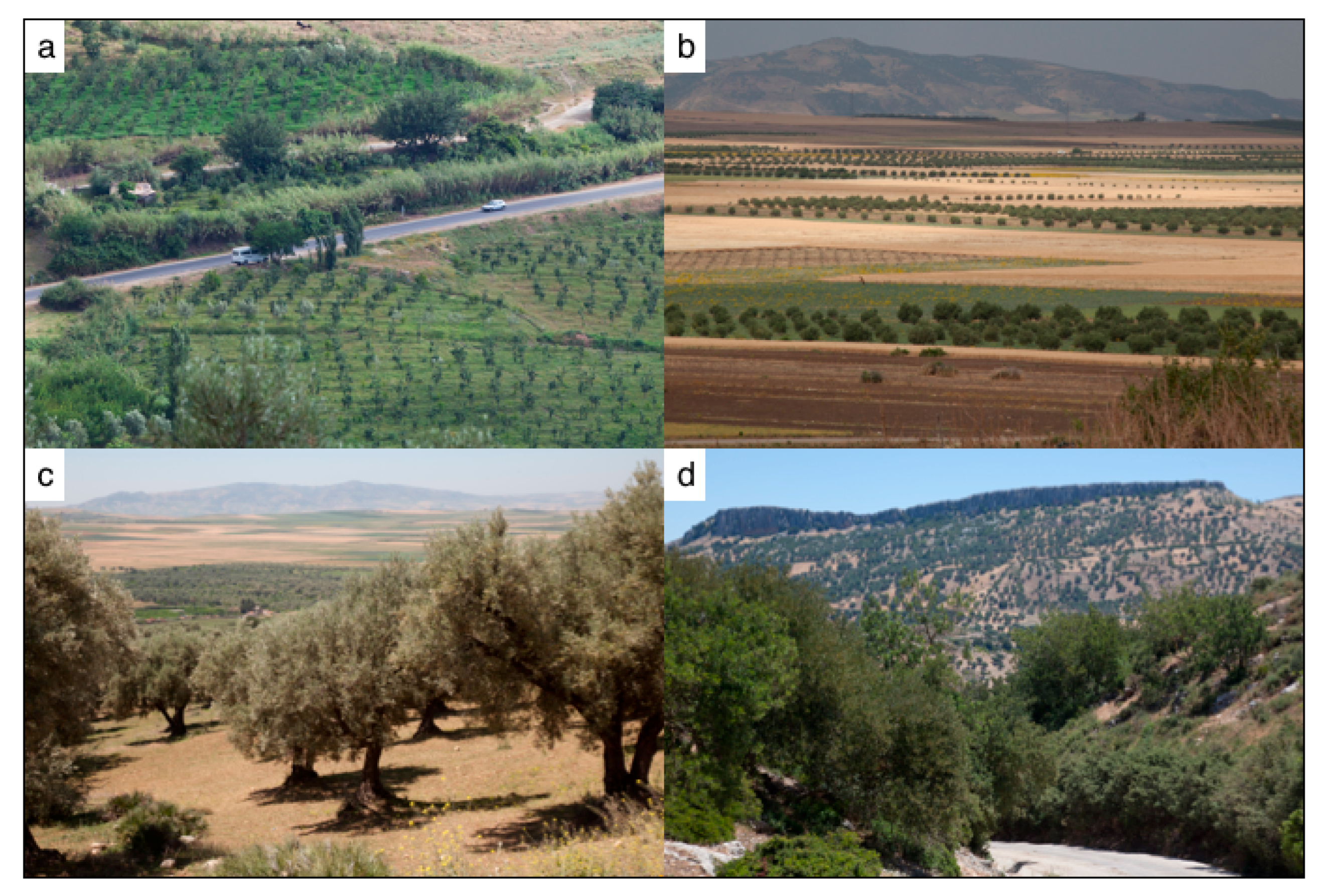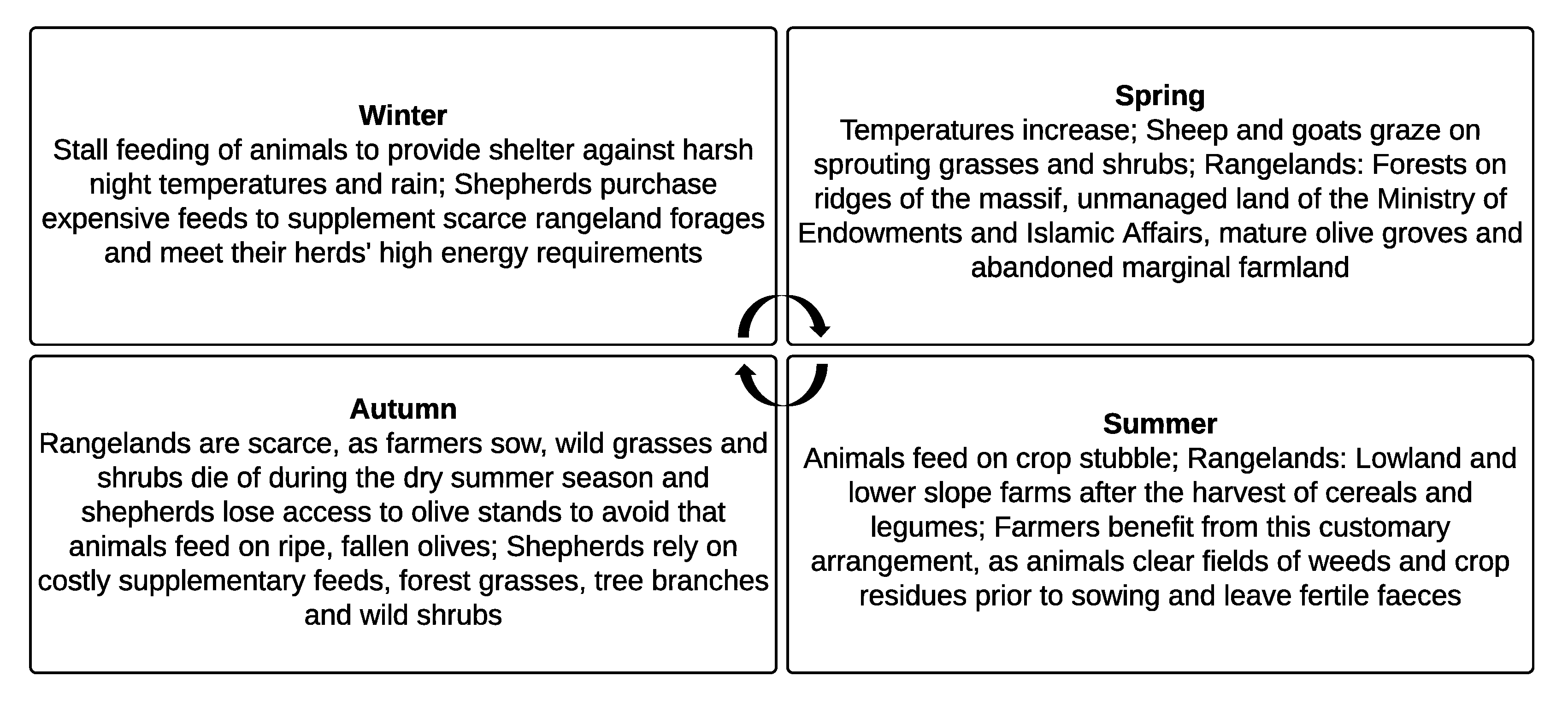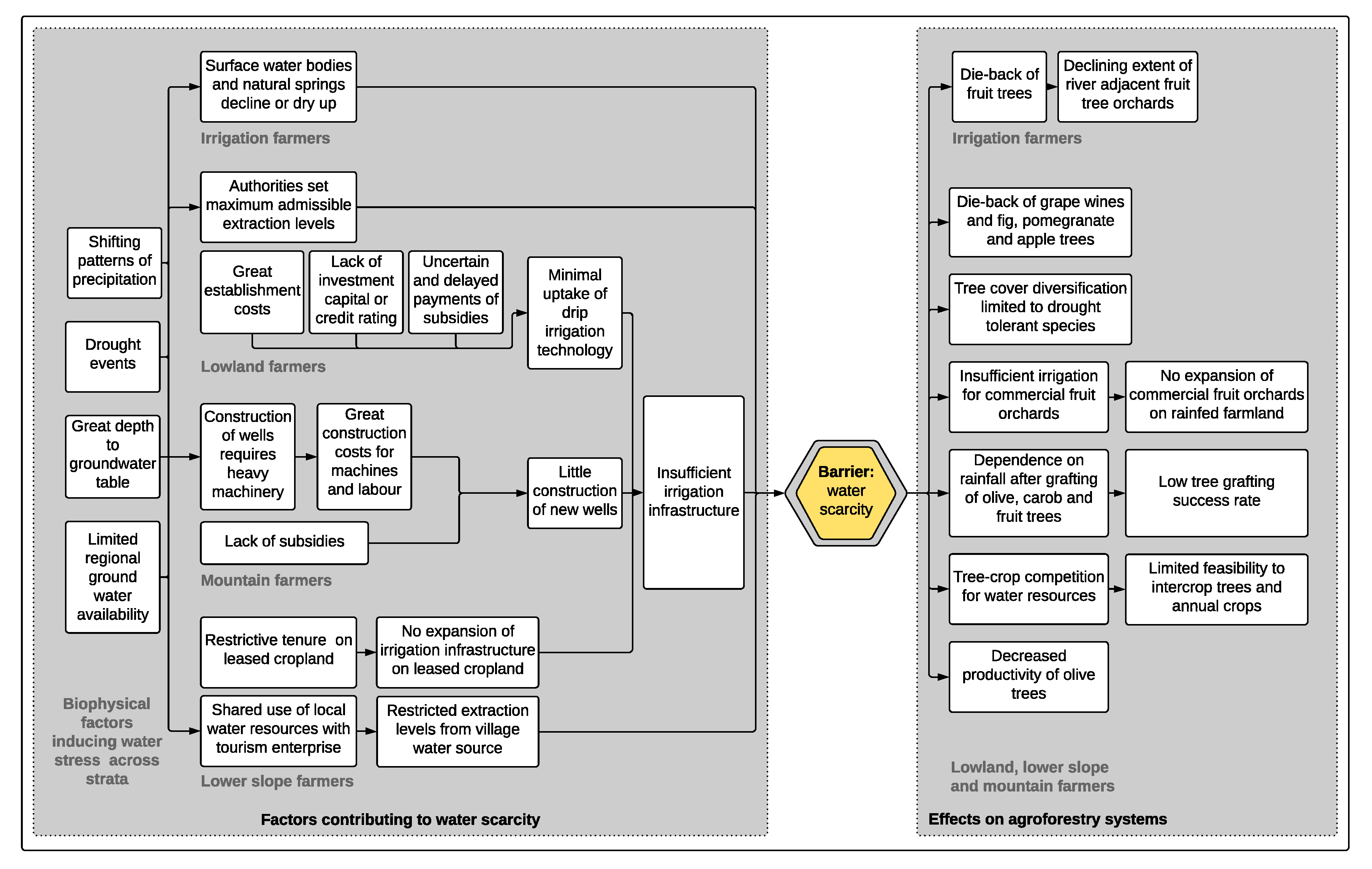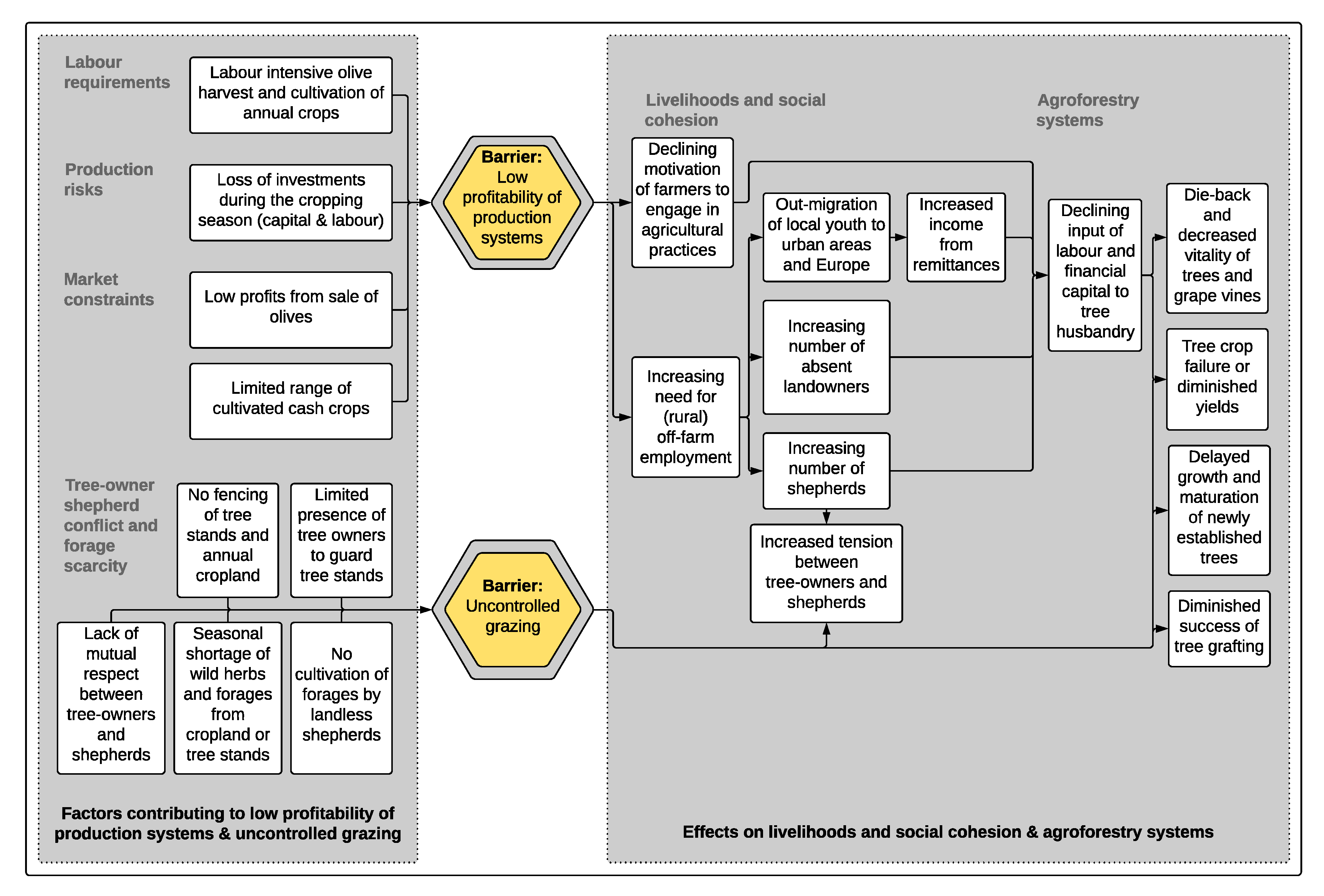Using Local Agroecological Knowledge in Climate Change Adaptation: A Study of Tree-Based Options in Northern Morocco
Abstract
:1. Introduction
2. Materials and Methods
2.1. Study Site
2.2. Data Collection and Analysis
3. Results
3.1. Characteristics of Farming Systems
3.2. Current Tree-Cover and Agroforestry Practices
3.3. Niches for Farm-Trees and Perceptions about Tree-Based Diversification
3.4. Perceived Barriers to Tree-Based Diversification
3.4.1. Water Scarcity
3.4.2. Low Profitability
3.4.3. Uncontrolled Grazing
3.5. Entry-Points for Tree-Based Adaptation, and Identified Extension and Innovation Priorities
4. Discussion
4.1. Farming System Characterisation with Local Agroecological Knowledge
4.2. Overcoming Adoption Barriers through Co-Learning and Cooperation
5. Conclusions
Author Contributions
Funding
Acknowledgments
Conflicts of Interest
Appendix A
| Characteristics | Farming Systems | ||||
|---|---|---|---|---|---|
| Irrigated Systems | Lowland Systems | Lower Slope Systems | Mountain Systems | Pastoral Systems | |
| Farm size | Up to 20 ha | ≤9 ha | Variable | Variable | Very small land holdings |
| Bio-physical conditions | Variable terrain (flat to steep) Erosion of river/stream banks High soil fertility Traditional flood irrigation (seguas, motorised pumps) | Flat terrain Low erosion High soil fertility (black soils) Rain fed with supplementary irrigation on minor areas | Moderate slopes Moderate to high erosion Moderate to low fertility (clay soils) Rain fed | Moderate to steep slopes Moderate to high erosion Moderate to low fertility (clay soils) Rain fed | Rangelands span lowland, lower slope and mountain systems, state forests and land administered by the Ministry of Endowments and Islamic Affairs |
| Agricultural systems | Predominantly commercial Cash crops: Fruit from irrigated orchards Vegetables and aromatic herbs Irrigated forages (e.g., maize) Domestic consumption: Fruit and vegetables | Predominantly commercial Cash crops: Wheat, white onions, fava beans, chickpeas, lentils Domestic consumption: Olives (table and oil) and fruit Legumes, cereals, vegetables Green forages for livestock | Commercial and subsistence Cash crops: Olives (oil) Surplus production of wheat, fava bean, chickpeas Domestic consumption: Olives and fruit Legumes, cereals, vegetables Oat and barley for livestock | Commercial and subsistence Cash crops: Olives (oil), carob seed pots, figs, some almonds Domestic consumption: Olives and fruit Legumes, cereals, vegetables Oat and barley for livestock | Commercial Income source: Rearing of small ruminants and cattle for meat production |
| Level of intensification | Intensive cultivation of fruit trees Great reliance on manual labour | Intensified cereal production; seeds and agro-chemical inputs Tractors and harvesters for cropland preparation, sowing and harvest of cereals | Annual cropping systems (foothills) resemble those of lowland farmers, partly machine accessible Extensive management of mature olive stands | Extensive cultivation of tree stands and annual crops Great reliance on manual labour | Low; open rangeland grazing |
| Key threats | New tree pests and diseases Stream bank erosion Potential loss and conflict over water resources Declining water resources and deterioration of irrigation infrastructure | Drought events and changing precipitation patterns Increasing pest and disease pressure Increasing costs for agro-chemical inputs Adverse market trends (cereals) Debt with agricultural bank | Drought events and changing precipitation patterns Olive pests and diseases Adverse market trends (olives) Damage to trees and crops from browsing livestock Loss of access to village water resources | Drought events and changing precipitation patterns Damage to trees and crops from browsing livestock Increasing need for off-farm employment Tree pests and diseases | Livestock diseases Increasing costs for supplementary forages (winter) Conflict with tree-owners and state forest staff over access to rangelands |
References
- Kadi, M.A.; Benoit, G. Agriculture 2030: A Future for Morocco. The Futures of Agriculture, Brief No. 41; Global Forum on Agricultural Research: Rome, Italy, 2012. [Google Scholar]
- Millenium Ecosystem Assessment. Ecosystems and Human Well-Being Synthesis; Island Press: Washington, DC, USA, 2005. [Google Scholar]
- United Nations. Global Drylands: A UN System-Wide Response; United Nations: New York, NY, USA, 2011. [Google Scholar]
- Rochdane, S.; Bounoua, L.; Zhang, P.; Imhoff, M.L.; Messouli, M.; Yacoubi-Khebiza, M. Combining Satellite Data and Models to Assess Vulnerability to Climate Change and Its Impact on Food Security in Morocco. Sustainability 2014, 6, 1729–1746. [Google Scholar] [CrossRef] [Green Version]
- Babqiqi, A.; Messouli, M. Simulation of climate and its implication on agriculture in Morocco using Statistical DownScaling. Int. J. Latest Res. Sci. Technol. 2013, 2, 83–96. [Google Scholar]
- Terink, W.; Immerzeel, W.W.; Droogers, P. Climate change projections of precipitation and reference evapotranspiration for the Middle East and Northern Africa until 2050. Int. J. Climatol. 2013, 33, 3055–3072. [Google Scholar] [CrossRef] [Green Version]
- Jarlan, L.; Abaoui, J.; Duchemin, B.; Ouldbba, A.; Tourre, Y.M.; Khabba, S.; Le Page, M.; Balaghi, R.; Mokssit, A.; Chehbouni, G. Linkages between common wheat yields and climate in Morocco (1982–2008). Int. J. Biometeorol. 2014, 58, 1489–1502. [Google Scholar] [CrossRef] [PubMed]
- Huppé, G.A.; Shaw, S.; Dion, J.; Voora, V. Food Price Inflation and Food Security: A Morocco case study. In IISD Report; The International Institute for Sustainable Development: Winnipeg, MB, Canada, 2013. [Google Scholar]
- FAO STAT. Country Profiles. Morocco. Available online: http://faostat.fao.org/site/666/default.aspx (accessed on 15 October 2018).
- The World Bank. Data. Agricultural Irrigated Land (% of Total Agricultural Land). Available online: https://data.worldbank.org/indicator/AG.LND.IRIG.AG.ZS?locations=MA (accessed on 12 September 2018).
- Daoui, K.; Fatemi, Z. Agroforestry Systems in Morocco. The Case of Olive Tree and Annual Crops Association in Sais Region. In Science, Policy and Politics of Modern Agricultural System. Global Context to Local Dynamics of Sustainable Agriculture; Behnassi, M., SHahid, S.A., Mintz-Habib, N., Eds.; Springer: Dordrecht, The Netherlands, 2014; pp. 281–289. [Google Scholar]
- Treesilience: An Assessment of the Resilience Provided by Trees in the Drylands of Eastern Africa; De Leeuw, J.; Njenga, M.; Wagner, B.; Iiyama, M. (Eds.) The World Agroforestry Centre (ICRAF): Nairobi, Kenia, 2014. [Google Scholar]
- Dixon, J.; Gulliver, A.; Gibbon, D. Farming Systems and Poverty. Improving Farmers’ Livelihoods in a Changing World; Hall, M., Ed.; Food and Agriculture Organization of the United Nations and The World Bank: Rome, Italy; Washington, DC, USA, 2001. [Google Scholar]
- Warburton, H.; Martin, A. Local People’s Knowledge in Natural Resources Research; Natural Resources Institute: Chatham, UK, 1999. [Google Scholar]
- Meijer, S.S.; Catacutan, D.; Ajayi, O.C.; Sileshi, G.W.; Nieuwenhuis, M. The role of knowledge, attitudes and perceptions in the uptake of agricultural and agroforestry innovations among smallholder farmers in sub-Saharan Africa. Int. J. Agric. Sustain. 2014. [Google Scholar] [CrossRef]
- Sinclair, F.L.; Walker, D.H. A Utilitarian Approach to the Incorporation of Local Knowledge in Agroforestry Research and Extension. In Agroforestry in Sustainable Agricultural Systems; CRC Press: Boca Raton, FL, USA, 1998. [Google Scholar]
- Coe, R.; Sinclair, F.; Barrios, E. Scaling up agroforestry requires research ‘in’ rather than ‘for’ development. Curr. Opin. Environ. Sustain. 2014, 6, 73–77. [Google Scholar] [CrossRef]
- Van Ginkel, M.; Sayer, J.; Sinclair, F.; Aw-Hassan, A.; Bossio, D.; Craufurd, P.; El Mourid, M.; Haddad, N.; Hoisington, D.; Johnson, N.; et al. An integrated agro-ecosystem and livelihood systems approach for the poor and vulnerable in dry areas. Food Secur. 2013, 5, 751–767. [Google Scholar] [CrossRef] [Green Version]
- Centre de Conseil Agricole Béni Amar. Monographie du CCA 2006; Centre de conseil agricole de Béni Amar: Béni Amar, Algeria, 2006. [Google Scholar]
- CGIAR. Action Site for Sustainable Intensification—Meknes-Saiss, Morocco. Available online: http://drylandsystems.cgiar.org/north-africa-and-west-asia/action-site-sustainable-intensification-%E2%80%93-meknes-saiss-morocco (accessed on 15 October 2015).
- Sinclair, F.L.; Walker, D.H. Acquiring qualitative knowledge about complex agroecosystems. Part 1: Representation as natural language. Agric. Syst. 1998, 56, 341–363. [Google Scholar] [CrossRef]
- Walker, D.H.; Sinclair, F.L. Acquiring qualitative knowledge about complex agroecosystems. Part 2: Formal representation. Agric. Syst. 1998, 56, 365–386. [Google Scholar] [CrossRef]
- Pretty, J.N.; Guijt, I.; Scoones, I.; Thompson, J. A Trainer’s Guide for Participatory Learning and Action; International Institut for Environment and Development: London, UK, 1995. [Google Scholar]
- Dixon, H.; Doores, J.W.; Joshi, L.; Sinclair, F. Agroecological Knowledge Toolkit for Windows: Methodological Guidelines, Computer Software And Manual For AKT5; School of Agricultural and Forest Sciences, University of Wales: Bangor, UK, 2001. [Google Scholar]
- Kendon, G.; Walker, D.H.; Robertson, D.; Haggith, M.; Sinclair, F.; Muetzelfeldt, R.L. Supporting costumised reasoning in the agroforestry domain. New Rev. Appl. Expert Syst. 1995, 1, 179–192. [Google Scholar]
- Walker, D.H.; Sinclair, F.; Kendon, G. A knowledge based systems approach to agroforestry research and extension. AI Appl. 1995, 9, 61–72. [Google Scholar]
- Direction Provinciale de l’agriculture de Meknes. Monographie Agricole de la Direction Provinciale de L’agriculture de Mèknes; Ministere de L’agriculture et de la Peche Maritime; Royaume de Maroc: Meknès, Morocco, 2007. [Google Scholar]
- Sekkat, A.; Boutaleb, A.J.; Amiri, S.; El Guili, M.; Achbani, E.; Echchgadda, G.; Tahiri, A.; Hamal, A.; Ouguas, Y.; Taleb, A. Ouvrage Technique L’Olivier. In Protection Raisonée de L’Olivier, Projet Arboriculture Frutière; INRA (Morocco): Meknes, Morocco, 2013. [Google Scholar]
- CBA Morocco Porgramme. Community-Based Adaptation. Project Proposal. Fouss G Fouss Association. Boumaad Douar. Fouss G Fouss Association for Culture, the Environment and Social Development; Rural Commune of Boudinar: Boudinar, Morocco, 2011. [Google Scholar]
- Bossert, T.; Cakir, V.; Bowser, D.; Mitchell, A. Exploratory Study of Social Capital and Social Programs in Morocco; Discussion Paper; Harvard School of Public Health: Boston, MA, USA, 2003. [Google Scholar]
- O’Connell, D.; Abel, N.; Grigg, N.; Maru, Y.; Butler, J.; Cowie, A.; Stone-Jovicich, S.; Walker, B.; Wise, R.; Ruhweza, A.; et al. Designing Projects in a Rapidly Changing World: Guidelines for Embedding Resilience, Adaptation and Transformation into Sustainable Development Projects. (Version 1.0); Global Environmental Facility: Washington, DC, USA, 2016. [Google Scholar]
- Bekkari, L.; del Castillo, I.Y. The appropriation of the water user association model by a community in the Middle Atlas region in Morocco. Cah. Agric. 2011, 20, 73–77. [Google Scholar]
- Stockholm Environment Institut. Rainwater Harvesting: A Liveline for Human-Wellbeing; United Nations Environment Programme and Stockholm Environment Institute: Stockholm, Sweden, 2009. [Google Scholar]
- Gyau, A.; Franzel, S.; Chiatoh, M.; Nimino, G.; Owusu, K. Collective action to improve market access for smallholder producers of agroforestry products: Key lessons learned with insights from Cameroon’s experience. Curr. Opin. Environ. Sustain. 2014, 6, 68–72. [Google Scholar] [CrossRef]
- Ouguas, Y.; Chemseddine, M. Effect of pruning and chemical control on Saissetia oleae (Olivier) (Hemiptera, Coccidae) in olives. Fruits 2011, 66, 225–234. [Google Scholar] [CrossRef]
- Bayala, J.; Kalinganire, A.; Tchoundjeu, Z.; Sinclair, F.; Garrity, D. Conservation agriculture with trees in the West African Sahel—A review. In ICRAF Occasional Paper No.14; World Agroforestry Centre: Nairobi, Kenya, 2011; Volume 14. [Google Scholar]
- Tiedeman, J. The Challenge of Rangeland Degradation in WANA: Going beyond Restoration. In ICARDA Caravan; The International Center for Agriculture Research in the Dry Areas (ICARDA): Aleppo, Syria, 2005; pp. 31–33. [Google Scholar]




| Typology According to Farmers’ Local Agroecological Knowledge | Tree Cover and Agroforestry Practices by Farming Systems | |||
|---|---|---|---|---|
| Irrigated Systems | Lowland Systems | Lower Slope Systems | Mountain Systems | |
| Very common cultivated species; well suited to rain fed farming (Olea europea, Ceratonia siliqua, Ficus carica, Prunus dulcis) | Rare; single dispersed trees in fruit orchards | O. europea in widely spaced, immature orchards (10 × 10 m) on cropland; O. europea in boundary plantings along field boundaries; few or single C. siliqua, F. carica or P. dulcis on cropland and near houses | O. europea in mature orchards; few or single C. siliqua dispersed in O. europea stands; few or single F. carica dispersed on cropland; O. europea, F. carica and P. dulcis in recently established mixed orchards on former cropland in the foothills | O. europea in mature orchards; some recently established O. europea orchards and stands rejuvenated through pollarding; smaller C. siliqua and F. carica stands of various ages and single trees in home gardens; small orchards of P. dulcis and single trees in home gardens |
| Other cultivated species; well suited to rain fed farming (Acacia cf. horrida, Agave sp., Opuntica ficus-indica) | n/a | Dispersed or in small clumps near houses | Living fences in settlements and along field boundaries | Living fences in settlements and along field boundaries |
| Common cultivated fruit tree species; to some extend suited to rain fed farming (Prunus armeniaca, Punica granatum) | Single trees in fruit tree orchards | Single trees in mixed clumps of fruit trees or in home gardens near houses | Single trees in mixed clumps of fruit trees or in home gardens near houses; immature P. granatum in recently established mixed orchards on former cropland in the foothills | Single trees in mixed clumps of fruit trees or in home gardens near houses |
| Common cultivated fruit tree species; unsuited to rain fed farming (Citrus spp., Cydonia oblonga, Morus alba, Prunus persica, Prunus spp., Pyrus spp., Vitis spp.) | Dominant; mostly in recently established commercial fruit tree orchards; single dispersed mature trees, established by previous farmer generations | Individual or clumps of up to ten trees on cropland or in home gardens near houses | Individual or clumps of up to ten trees on cropland or in home gardens near houses; Vitis spp. on extensively managed or semi-abandoned farmland near ridges | Individual or clumps of up to ten trees on cropland or in home gardens near houses; remnant and declining Vitis spp. established by previous farmer generations in orchards or on cropland |
| Rare cultivated fruit tree species; unsuited to rain fed farming (Eriobotrya japonica, Malus domestica, Ziziphus jujuba) | Single E. japonica and Z. jujuba; few M. domestica in decline | Single trees on cropland | n/a | n/a |
| Wild or remnant species on farms (Arbutus unedo, Celtis australis, Fraxinus cf. angustifolia, Tamarix cf. aphylla, Chamaerops humilis, Crateagus sp., Cupressus sempervirens, Eucalyptus spp., Nerium oleander, Olea europea var. Oleaster, Pinus spp., Pistacia atlantica, Pistacia lentiscus, Populus sp., Quercus cf. rotundifolia, Ricinus communis, Ziziphus lotus) | Rare; alongside stream banks | Very rare; dispersed alongside roads or field boundaries; few remnant trees near houses, established during post-colonial French settlement | Commonly retained in hedgerows along field boundaries; few remnant trees near houses, established during post-colonial French settlement; wild shrubs and trees on extensively managed or semi-abandoned farmland near ridges | Commonly retained in hedgerows along field boundaries; alongside roads and stream banks on cropland |
© 2018 by the authors. Licensee MDPI, Basel, Switzerland. This article is an open access article distributed under the terms and conditions of the Creative Commons Attribution (CC BY) license (http://creativecommons.org/licenses/by/4.0/).
Share and Cite
Kmoch, L.; Pagella, T.; Palm, M.; Sinclair, F. Using Local Agroecological Knowledge in Climate Change Adaptation: A Study of Tree-Based Options in Northern Morocco. Sustainability 2018, 10, 3719. https://doi.org/10.3390/su10103719
Kmoch L, Pagella T, Palm M, Sinclair F. Using Local Agroecological Knowledge in Climate Change Adaptation: A Study of Tree-Based Options in Northern Morocco. Sustainability. 2018; 10(10):3719. https://doi.org/10.3390/su10103719
Chicago/Turabian StyleKmoch, Laura, Tim Pagella, Matilda Palm, and Fergus Sinclair. 2018. "Using Local Agroecological Knowledge in Climate Change Adaptation: A Study of Tree-Based Options in Northern Morocco" Sustainability 10, no. 10: 3719. https://doi.org/10.3390/su10103719





